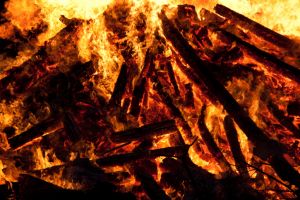
The recent major earthquake in Nepal has impacted thousands of lives across the country. In Katmandu alone, over 800 people have died in a quake that measured 7.8 on the Richter scale. As in any catastrophe, great energy is being applied to restore essential services and get people the help they need. In the midst of the chaos, thousands of Hindu survivors are struggling to arrange funeral services that include the prompt cremation of their loves ones' bodies. It is a task that is becoming increasingly herculean. Riverside cremation stones are booked continuously day and night in an attempt to accommodate the needs of the families of the dead. Normally there may be 15 to 20 cremations a day in Katmandu. Post-quake, there are several hundred ceremonies scheduled daily, with families waiting to get onto the list.
A Complex Ritual
Under normal circumstances, a loved one's body would be cremated the day of his or her death, or within 24 hours. The body is wrapped in a cloth or sheet and laid out on a bamboo stretcher. Family members proceed to dust the face and body in a red powder. Small bits of money and jewelry are set around the body and over the heart. A professional burner is hired to arrange for the cremation pyre and tend to the burning process. Katmandu currently has 11 stone platforms for this use. A wood similar to teak is arranged in a rectangle and the bamboo stretcher is placed atop. Ghee, or clarified butter, is positioned around the wood to help ignition. Typically, it is the job of the eldest male child to touch a torch or burning sticks to the loved one's lips, sending him or her on the journey. A blue smoke emanates from the pyre. The professional burner then tends the flames, adjusting the fire and adding straw until the body has been completely turned to ash. The remains are then pushed into the Baghmati and the stone is cleaned for the next cremation.
Backlog of Ceremonies
There are so many people in need of services right now, professional funeral operators have more work than they can handle. Also, the number of survivors seeking services has burdened a grave but inherently peaceful business. Resources, including people to perform services, are scarce. Ordinarily in Katmandu, the family may arrange a cremation fairly quickly for their loved one. Preparations include:
- Hiring the professional burner
- Purchasing wood
- Reserving and paying for ceremony space
- Hiring pall bearers
With the country in crisis and general disarray, normally simple preparations have become difficult to manage. Hindu mourners may be seen attending to bodies while wearing surgical masks to protect against the proliferation of thick smoke in the air. In addition, there are challenges to keeping the bodies of loved ones in readiness for their turn at the cremation stones. Hundreds of homes and other structures have been destroyed or severely compromised. The situation becomes more complex as family members pour into the city from overseas to tend to the funeral arrangements of their loved ones.
Vital Service
In a disaster of this magnitude, public concern logically falls to caring for the living. Global efforts began almost immediately to secure material goods and resources for survivors of the earthquake. It is a testament to the devotion of Hindus to their faith that so many are making a concerted effort to perform the sacred funeral services considered essential to Hindu practice. It may be difficult to project what impact the ongoing and continuous cremations may have on the environment and its human inhabitants. Despite the challenges, however, it is clear that Hindus in Katmandu are making their best effort to honor both their faith and those that have fallen in this catastrophe.
Add Your Comment